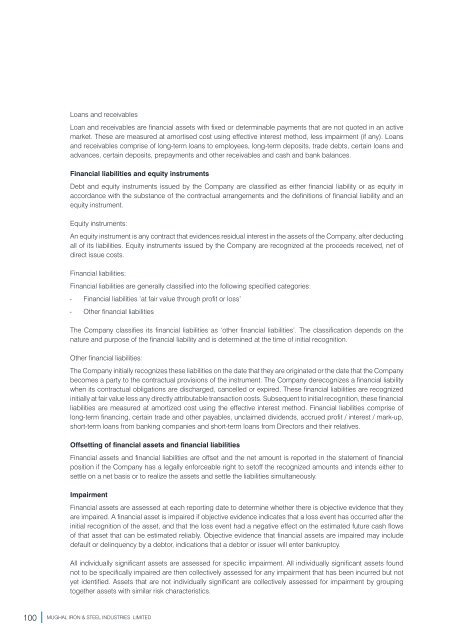MS AR 2018 (1)
You also want an ePaper? Increase the reach of your titles
YUMPU automatically turns print PDFs into web optimized ePapers that Google loves.
Loans and receivables<br />
Loan and receivables are financial assets with fixed or determinable payments that are not quoted in an active<br />
market. These are measured at amortised cost using effective interest method, less impairment (if any). Loans<br />
and receivables comprise of long-term loans to employees, long-term deposits, trade debts, certain loans and<br />
advances, certain deposits, prepayments and other receivables and cash and bank balances.<br />
Financial liabilities and equity instruments<br />
Debt and equity instruments issued by the Company are classified as either financial liability or as equity in<br />
accordance with the substance of the contractual arrangements and the definitions of financial liability and an<br />
equity instrument.<br />
Equity instruments:<br />
An equity instrument is any contract that evidences residual interest in the assets of the Company, after deducting<br />
all of its liabilities. Equity instruments issued by the Company are recognized at the proceeds received, net of<br />
direct issue costs.<br />
Financial liabilities:<br />
Financial liabilities are generally classified into the following specified categories:<br />
- Financial liabilities ‘at fair value through profit or loss’<br />
- Other financial liabilities<br />
The Company classifies its financial liabilities as ‘other financial liabilities’. The classification depends on the<br />
nature and purpose of the financial liability and is determined at the time of initial recognition.<br />
Other financial liabilities:<br />
The Company initially recognizes these liabilities on the date that they are originated or the date that the Company<br />
becomes a party to the contractual provisions of the instrument. The Company derecognizes a financial liability<br />
when its contractual obligations are discharged, cancelled or expired. These financial liabilities are recognized<br />
initially at fair value less any directly attributable transaction costs. Subsequent to initial recognition, these financial<br />
liabilities are measured at amortized cost using the effective interest method. Financial liabilities comprise of<br />
long-term financing, certain trade and other payables, unclaimed dividends, accrued profit / interest / mark-up,<br />
short-term loans from banking companies and short-term loans from Directors and their relatives.<br />
Offsetting of financial assets and financial liabilities<br />
Financial assets and financial liabilities are offset and the net amount is reported in the statement of financial<br />
position if the Company has a legally enforceable right to setoff the recognized amounts and intends either to<br />
settle on a net basis or to realize the assets and settle the liabilities simultaneously.<br />
Impairment<br />
Financial assets are assessed at each reporting date to determine whether there is objective evidence that they<br />
are impaired. A financial asset is impaired if objective evidence indicates that a loss event has occurred after the<br />
initial recognition of the asset, and that the loss event had a negative effect on the estimated future cash flows<br />
of that asset that can be estimated reliably. Objective evidence that financial assets are impaired may include<br />
default or delinquency by a debtor, indications that a debtor or issuer will enter bankruptcy.<br />
All individually significant assets are assessed for specific impairment. All individually significant assets found<br />
not to be specifically impaired are then collectively assessed for any impairment that has been incurred but not<br />
yet identified. Assets that are not individually significant are collectively assessed for impairment by grouping<br />
together assets with similar risk characteristics.<br />
100 MUGHAL IRON & STEEL INDUSTRIES LIMITED


